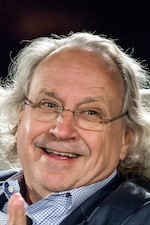2021 Recipients of C&C Prize
Group B

Prof. Rodney Brooks
Professor of Robotics (Emeritus), Massachusetts Institute of Technology
CTO, Robust.AI
Citation
For Outstanding Leadership in Introducing Subsumption Architecture for Robot Control and Promoting the Practical Use of Autonomous Robots
Achievements
Autonomous robots that can operate without human intervention are increasingly being used in a wide range of scenarios ranging from cleaning, security, and luggage maneuvering to disaster relief, military operations, and space exploration. With robots also becoming more affordable and more convenient, robotic vacuums are now sweeping floors in thousands of homes. Robots will continue to evolve in the future and become common features in homes, workplaces, stores, factories and other locations, fulfilling tasks in place of and in collaboration with humans.
Robots first came into widespread use in the industrial sector. When industrial robots were first introduced in the 1960s, robotic arms became a common feature at production facilities, where they were used to execute a range of tasks in place of humans. The early industrial robots were limited to executing tasks for which they were programmed. Research later began into autonomous robots that have the ability to make their own decisions and then perform actions accordingly. In the early 1980s, autonomous mobile robots were still oversized, slow, expensive, and unreliable. Robot control systems at that time conventionally used artificial intelligence to centrally process information obtained from various sensors to create an action plan for the robot to perform. Complex programs resulted in bugs and delays in the robot's response, and the robot platforms were expensive.
Prof. Brooks became a Professor of Robotics at MIT in 1984. From 1997-2003 and from 2003-2007 he was, respectively, Director of the Artificial Intelligence Lab and of the Computer Science and Artificial Intelligence Lab (CSAIL). In 1986, Prof. Brooks proposed subsumption architecture (SA) – a concept of artificial intelligence based on behavior inspired by the movements of insects. This new architecture subsequently influenced research and development in autonomous robots and real-time artificial intelligence. SA is a hierarchical modular approach to robot control systems whereby complex behaviors for achieving a goal are divided into a number of simple tasks, with the higher level modules subsuming the high-priority modules at the lower levels. The modules compete and collaborate during control of the robot to enable it to flexibly adapt to the dynamically changing environment. The division of the control system into modules has resulted in simpler and smaller control structures, leading to improved responsiveness and lower cost robot platforms.
Following the announcement of SA, Prof. Brooks and his team began their research on SA-based autonomous robots. In the late 1980s, they developed their first SA-based robot, called Allen. In the 1990s, they developed the first autonomous mobile robot, Polly, which served as a tour guide for the Lab for Artificial Intelligence. In 1993, they launched the Cog project and constructed an upper-torso humanoid robot called Cog to explore the issues of developmental structure, physical embodiment, integration of multiple sensory and motor systems, and social interaction.
Prof. Brooks was not only a roboticist, he was also a robotics entrepreneur. In 1990, he co-founded iRobot with his students Colin Angle and Helen Greiner, with whom he produced a six-legged autonomous walking robot called Genghis in 1991. In 1997, they developed the multi-purpose Urbie robot, which eventually evolved into the PackBot. Used in military operations, the single-armed PackBot weighed 18 kg and was capable of opening and passing through doors as well as transmitting images. PackBots were also used in search-and-rescue efforts at Ground Zero in New York after 9/11 and aided in measuring radiation levels and taking videos inside the reactor buildings after the meltdown in Fukushima in 2011. The company also developed a variety of robots for different applications, including the Roomba, an autonomous vacuum introduced in 2002. With the ability to keep every inch of a room spotless all while moving around obstacles and avoiding stairs, this unique robot has helped forge a path and create a market for robot vacuums. Since its inception, more than 30 million units have been sold worldwide.
In 2008, Prof. Brooks co-founded Rethink Robotics, which developed an industrial robot called Baxter that is designed to safely interact with nearby human workers and is programmed to perform simple tasks. This robot was often used for research purposes. In 2019, Prof. Brooks co-founded Robust.AI, where he is currently working on developing an operating system for robots.
Prof. Brook’s introduction of the subsumption architecture (SA) in robotics, extensive research on autonomous mobile robots, and pioneering work in developing practical robots as a robotics entrepreneur paved the way to creating and expanding the market for autonomous robots. Because of the outstanding contributions he has made in promoting the widespread use of industrial and domestic autonomous robots, we believe Prof. Brooks would be an excellent recipient of the C&C Prize.
